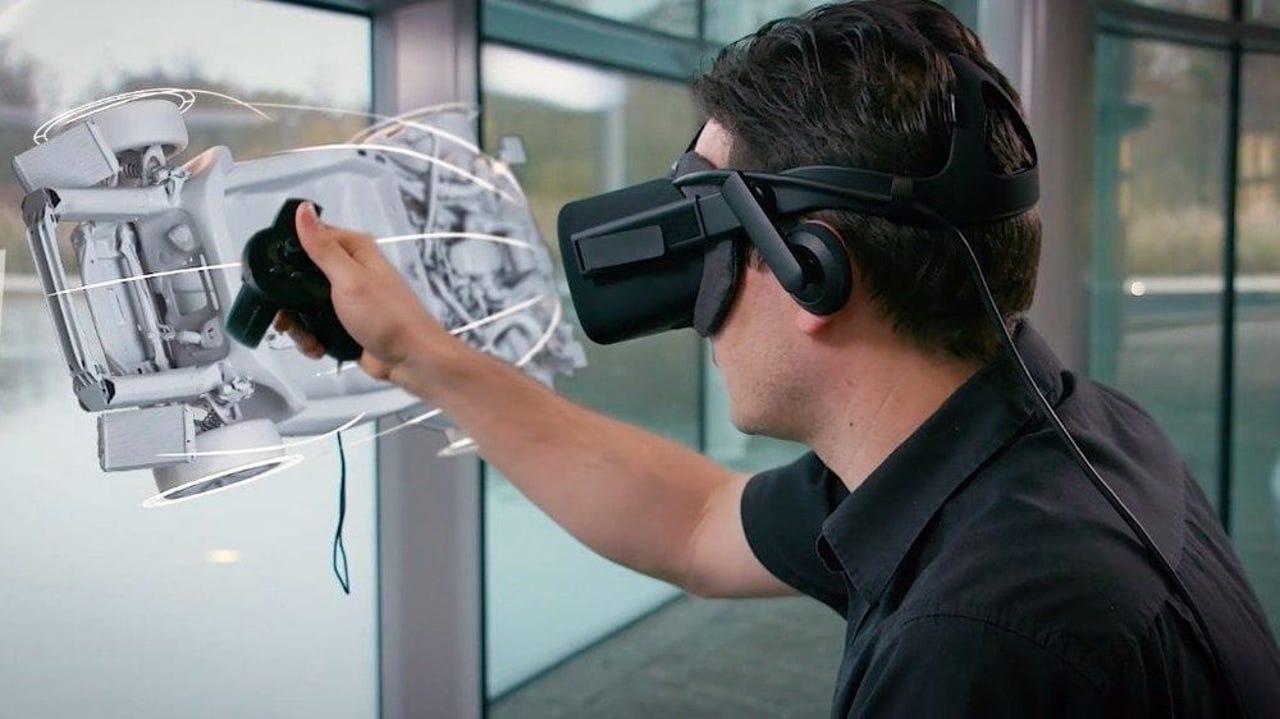HP unveils Opera Glass for "VR snacking"


This week, HP unveiled a VR proof of concept called Opera Glass, a standby VR headset designed to live on a desk. According to HP Labs, the hardware enables something called "VR snacking."
Somewhat disappointingly, that has nothing to do with simulated food.
Instead, Opera Glass is supposed to solve a problem common in fields like architecture, engineering, and product design. When doing CAD design on a desktop, designers frequently find it necessary to switch from a primary display to a simulated 3D display. To strain a metaphor, most design work focuses on the trees, but it's often necessary for designers to zoom out and look at the forest.
ZDNet: Black Friday 2018 deals: Business Bargain Hunter's top picks | Cyber Monday 2018 deals: Business Bargain Hunter's top picks
VR is great for getting an accurate sense of how a design-in-progress looks at scale, but the transition from a primary monitor to a VR headset can be cumbersome. It's an easy notion to scoff at -- after all, putting a pre-adjusted headset on takes a few seconds, at most.
But if you've ever watched a designer at work, you know the process is heavily reliant on concentration. It's akin, in fact, to a process that will be familiar to coders. At peak productivity, designers enter a flow space.
CNET: Black Friday 2018: The best deals on sale right now | The best Black Friday deals of 2018: The Cheapskate's picks | Black Friday 2018 Amazon deals now available
In that context, even a few seconds can disrupt the creative process. HP thinks Opera Glass can help. The unit consists of a pair of VR goggles perched atop a desk stand. The configuration enables designers to bend down and take a gander without breaking concentration. It also enables designers to quickly share their progress with collaborators, which is a bit more challenging with a VR headset that requires re-adjustment.
An HP spokesperson shared a real world example with me:
"A designer is designing a new chair for a client. He builds a rough foamboard model. Based on the model, the designer drafts the chair in 3D CAD. The designer spends a long time working on the back of the chair, but he's not sure if it makes sense at scale. VR would allow the designer to view the chair model at the right proportions, but it disrupts the workflow to put on all the gear and move to the dedicated VR space. HP Labs asked, What if. . . Without leaving the desk, the designer grabs the VR Opera Glasses and looks through the VR view. The chair is virtually presented at full scale. The designer returns to 3D CAD and modifies the design. The designer can quickly - nearly seamlessly - switch from 3D CAD to VR without getting up or gearing up."
The proof of concept was unveiled at the Autodesk University Conference in Las Vegas. If HP ends up going to market with the design, it'll be an interesting case study in niche VR hardware. While there are plenty of VR systems designed for B2B, we haven't seen much enterprise VR hardware for specific types of professionals yet.
TechRepublic: Black Friday 2018: Best deals for professionals | Adobe Creative Cloud gets 25% discount for Black Friday | A guide to tech and non-tech holiday gifts to buy online
Because workers in the targeted professions are often freelancers or members of small teams, the product could straddle a compelling line between B2C and B2B hardware, much the way professional computers do. It's an affirmation that we're still very much in the wild west days of VR technology and that the market segments aren't yet fully baked.
Best gifts for co-workers under $50 on Amazon
Best Black Friday 2018 deals:
- Amazon Seven Days of Black Friday Deals: All-time lows on office devices
- Amazon Black Friday 2018 deals: See early sales on Echo, Fire HD
- Best Buy Black Friday 2018 deals: Deep discounts on Apple Mac, Microsoft Surface
- Target Black Friday 2018 deals: $250 iPad mini 4, $120 Chromebook
- Walmart Black Friday 2018 deals: $99 Chromebook, $89 Windows 2-in-1
- Dell Black Friday 2018 deals: $120 Inspiron laptop, $500 gaming desktop
- Newegg Black Friday 2018 deals: $50 off Moto G6, $70 off Nest thermostat
- Office Depot Black Friday 2018 deals: $300 off Lenovo Flex, $129 HP Chromebook
- eBay Black Friday 2018 deals: See early sales on Galaxy Watch, Chromecast
- Lenovo Black Friday 2018 deals: ThinkPad laptops and more
- Microsoft Store Black Friday 2018 deals: Ad showcases Surface, laptop deals
- Windows laptops Black Friday deals: Dell, HP, Lenovo
- Chromebook Black Friday 2018 deals: Dell, Google, HP
- Best tablet Black Friday deals: Apple iPad, Amazon Fire
- Black Friday 2018 iPhone deals: $400 iPhone X gift card, BOGO iPhone XR
- Black Friday 2018 smartphone deals: OnePlus 6T, LG G7